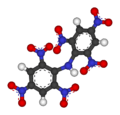Hexanitrodiphenylamine
| Hexanitrodiphenylamine | ||
|---|---|---|
 |
 | |
| IUPAC name 2,4,6-Trinitro-N-(2,4,6-trinitrophenyl)aniline | ||
| Other names HNDA; HNDPA; Dipicrylamine; Hexamine; hexil; hexyl; hexite; hexamin; GE - Hexa; IT - Esanitro difenilamina | ||
| Identifiers | ||
| CAS number | 131-73-7 | |
| PubChem | 8576 | |
| Jmol-3D images | {{#if:C1=C(C=C(C(=C1[N+](=O)[O-])NC2=C(C=C(C=C2[N+](=O)[O-])[N+](=O)[O-])[N+](=O)[O-])[N+](=O)[O-])[N+](=O)[O-]|Image 1 | |
| ||
| Properties | ||
| Molecular formula | C12H5N7O12 | |
| Molar mass | 439.21 g mol−1 | |
| Appearance | Crystalline solid. Yellow to orange. As ordinarily manufactured, it is yellow brown. | |
| Density | 1.64 g/cm3 (pressed) | |
| Melting point | 469° to 473 °F (243° to 245 °C) with decomposition. | |
| Solubility in water | Soluble in acetone, warm glacial acetic acid, nitric acid, or aqueous alkalies except potassium hydroxide. | |
| Except where noted otherwise, data are given for materials in their standard state (at 25 °C (77 °F), 100 kPa) | ||
| Infobox references | ||
Hexanitrodiphenylamine (abbreviated HND), is an explosive chemical compound with the formula C12H5N7O12. HND was used extensively by the Japanese during World War II but was discontinued due to its toxicity.
Preparation
Dinitrodiphenylamine is treated with 98% nitric acid. The starting material, dinitrodiphenylamine, is obtained from the reaction of aniline, dinitrochlorobenzene, and soda ash.
Applications
HND is a booster-class explosive that was used in World War II by the Germans as a component of Hexanite (60% TNT - 40% HND) and by the Japanese as a component of Kongo (Type 98 H2) (60% Trinitroanisol - 40% HND) for use in bombs, sea mines and depth charges; Seigate (Type 97 H) (60% TNT - 40% HND) for use in torpedo warheads and depth charges; and also in Otsu-B (60% TNT, 24% HND & 16% aluminium powder) for use in torpedo warheads.
Its ammonium salt, also known as Aurantia or Imperial Yellow, was discovered in 1873 by Emil Kopp and used as a yellow colorant for leather, wool and silk in the 19th and early 20th centuries.[1]
Safety and toxicity
A most toxic and poisonous explosive, it attacks the skin, causing blisters which resemble burns. Dust from HND is injurious to the mucous membranes of the mouth, nose, and lungs.
See also
References
- TM 9-1985-4 Japanese Explosive Ordnance (Bombs, Bomb fuzes, Land mines, Grenades, Firing Devices and Sabotage Devices). Departments of the Army and Air Force. March 1953.
- TM 9-1985-5 Japanese Explosive Ordnance (Army Ammunition, Navy Ammunition). Departments of the Army and Air Force. March 1953.
- Japanese Explosives (USNTMJ-200E-0551-0578 Report 0-25) (Report). U.S. Naval Technical Mission to Japan. December 1945.